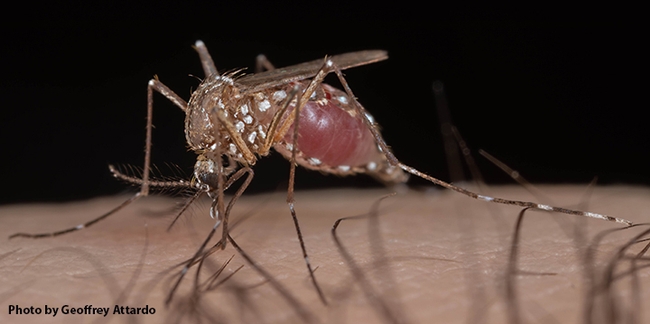- Author: Kathy Keatley Garvey

Infected Ae. aegypti mosquitoes can transmit dengue fever, chikungunya, Zika fever, Mayaro and yellow fever viruses, and other disease agents.
Mack will present her exit seminar on "Genetic and Molecular Factors Influencing Pyrethroid Response in Aedes aegypti from California" at 3:30 p.m., Tuesday, June 6 in 366 Briggs Hall. It also will be on Zoom.
Mack studies Ae. aegypti with a focus on analysis of transcriptomic datasets and 3D imaging datasets. "Throughout my time in graduate school, my projects have considered pyrethroid resistance in Ae. aegypti; examining the genetic response to this insecticide. As I finish up my dissertation, I hope to pursue a career in industry using the skills I've developed to continue to analyze large datasets!"
Insecticide resistance is a global issue, Mack says in her exit seminar abstract. The mosquito was first colonized California in 2013 and arrived resistant to pyrethroids. "The pyrethroid target site genotype differs geographically in California and partially infers resistance phenotype, indicating that other mechanisms are at play as well."
Mack is the co-lead author (with doctoral candidate Erin Taylor Kelly of the Attardo lab) of Frequency of Sodium Channel Genotypes and Association with Pyrethrum Knockdown Time in Populations of Californian Aedes aegypti, published in March 2021 in the journal Parasites and Vectors. The eight co-authors, in additioin to Attardo, included Anthony Cornel, Mosquito Control Research Laboratory, Kearney Agricultural Center, and Department of Entomology and Nematology.
"Since their detection in 2013, Aedes aegypti has become a widespread urban pest in California," the co-authors wrote in the abstract. "The availability of cryptic larval breeding sites in residential areas and resistance to insecticides pose significant challenges to control efforts. Resistance to pyrethroids is largely attributed to mutations in the voltage gated sodium channels (VGSC), the pyrethroid site of action. However, past studies have indicated that VGSC mutations may not be entirely predictive of the observed resistance phenotype."
"To investigate the frequencies of VGSC mutations and the relationship with pyrethroid insecticide resistance in California, we sampled Ae. aegypti from four locations in the Central Valley, and the Greater Los Angeles area. Mosquitoes from each location were subjected to an individual pyrethrum bottle bioassay to determine knockdown times. A subset of assayed mosquitoes from each location was then analyzed to determine the composition of 5 single nucleotide polymorphism (SNP) loci within the VGSC gene."
The conclusion:
"Resistance associated VGSC SNPs are prevalent, particularly in the Central Valley. Interestingly, among mosquitoes carrying all 4 resistance associated SNPs, we observe significant heterogeneity in bottle bioassay profiles suggesting that other mechanisms are important to the individual resistance of Ae. aegypti in California."
Mack, who holds a bachelor of science degree (2018) in biology from Creighton University, Omaha, Neb., enrolled in the UC Davis graduate school program in 2018.
Active in the Entomological Society of America, Mack scored second place in student competition at the 2022 joint meeting of the Entomological Societies of America, Canada, and British Columbia, held last November in Vancouver, British Columbia. She entered her presentation, "Three Dimensional Analysis of Vitellogenesis in Aedes aegypi Using Synchrotron X-Ray MicroCT,” in the category, "Graduate School Physiology, Biochemistry and Toxicology: Physiology.
Her abstract: "Traditional methods of viewing the internal anatomy of insects require some degree of tissue manipulation and/or destruction. Using synchrotron-based x-ray phase contrast microCT (pcMicroCT) avoids this issue and has the capability to produce high contrast, three dimensional images. Our lab is using this technique to study the morphological changes occurring in the mosquito Aedes aegypti during its reproductive cycle. Ae. aegypti is the primary global arbovirus vector, present on all continents except Antarctica. Their ability to spread these viruses is tightly linked with their ability to reproduce, as the production of eggs in this species is initiated by blood feeding. Amazingly, this species produces a full cohort of eggs (typically 50-100) in just 3 days' time following a blood meal. This rapid development represents dramatic shifts in physiological processes that result in massive volumetric changes to internal anatomy over time. To explore these changes thoroughly, a time course of microCT scans were completed over the vitellogenic period. This dataset provides a virtual representation of the volumetric, conformational, and positional changes occurring in tissues important for reproduction across the vitellogenic period. This dataset provides the field of vector biology with a detailed three-dimensional internal atlas of the processes of vitellogenesis in Ae. aegypti."
"As for career plans, I am applying to computational biology positions in industry," Mack said. "I'm not filing my dissertation until July so I am still working on this."
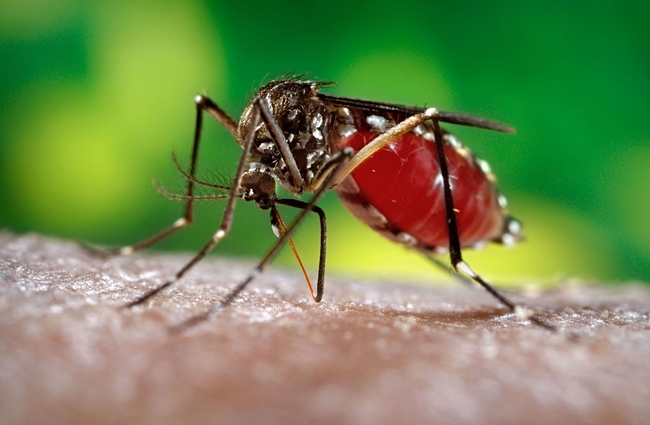
- Author: Kathy Keatley Garvey
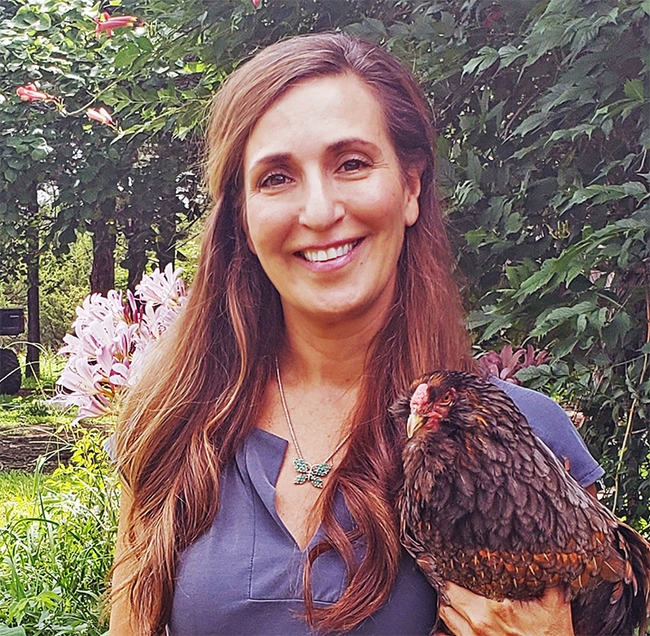
Research molecular biologist Dana Nayduch of the Agricultural Research Service, U. S. Department of Agriculture (USDA-ARS), will speak on "Can Surveying Microbial Communities of House Flies Help Us Understand Emerging Threats to Animal and Human Health?" at 4:10 p.m., Wednesday, March 1 in 122 Briggs Hall, Kleiber Hall Drive, UC Davis campus.
Her lecture also will be virtual. The Zoom link:
https://ucdavis.zoom.us/j/95882849672
Nayduch, based in Manhattan, Kansas, will be introduced by her colleague, medical entomologist-geneticist Geoffrey Attardo, assistant professor, UC Davis Department of Entomology and Nematology.
"Dana is doing very cool work with house flies and looking at how bacteria in the fly are trading antibiotic resistance genes among themselves," said Attardo. "It's an interesting and scary system as antibiotic resistance is so high due to antibiotic usage in livestock rearing."
"House flies (Musca domestica L.) are ubiquitous, cosmopolitan pests inhabiting urban, rural and agricultural environments throughout the world. In these habitats acquire microbes from septic substrates that are used for feeding and reproduction, Nayduch says in her abstract. "Flies subsequently harbor and disseminate these microorganisms which may pose a risk to human and animal health. Our research characterizes and analyzes microbial communities of house flies using culture-based and molecular approaches in order to better understand their roles in the transmission of important bacterial disease agents and/or antimicrobial resistance. Because the microbial communities within house flies represent a snapshot of the microbes found in their local habitat, we also gain valuable insight into existing and emerging microbial threats to humanand animal health through our surveys which can help in predicting and preventing disease."
A pre-seminar coffee will take place from 3:30 to 4:10 in 158 Briggs.
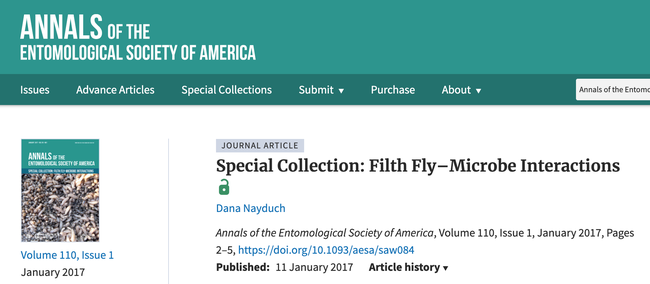
Dana received her bachelor's degree in animal science from Rutgers University and her doctorate in zoology from Clemson University, where she studied house flies as vectors for pathogens. She served as a postdoctoral fellow at Yale University School of Public Health, working on molecular-genetic studies of tsetse flies. She then joined Georgia Southern University (GSU) as an assistant professor of biology in 2004, advancing to associate professor in 2009. At GSU she received NIH-R15 funding to study house fly-microbe molecular interactions.
Active in the Entomological Society of America (ESA), Nayduch is the vice president-elect of the Medical, Urban and Veterinary Entomology (MUVE) Section. A peer reviewer for the Journal of Medical Entomology and an editorial board member and subject editor for Annals for ESA, she organized and edited the first special collection for Annals: “Filth Fly-Microbe Interactions."
The UC Davis Department of Entomology and Nematology's winter seminars are held on Wednesdays at 4:10 p.m. in 122 Briggs Hall. All are virtual. Urban landscape entomologist Emily Meineke, assistant professor, coordinates the seminars. (See schedule.) She may be reached at ekmeineke@ucdavis.edu for technical issues.
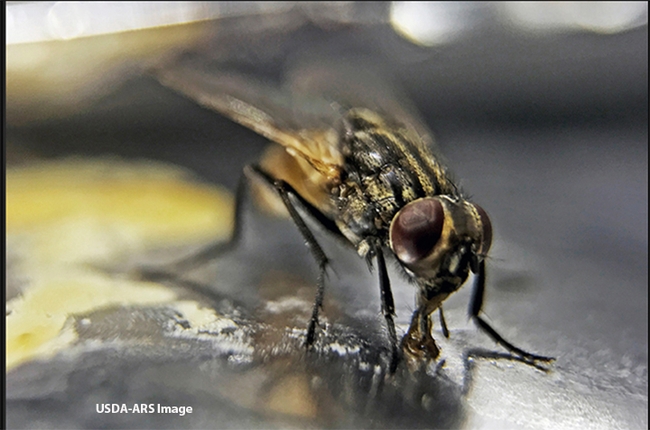
- Author: Kathy Keatley Garvey

- Medical entomologist-geneticist Geoffrey Attardo, assistant professor, will receive the Medical, Urban, and Veterinary Entomology Award
- Doctoral student Erin Taylor Kelly of the Geoffrey Attardo laboratory will receive the Student Leadership Award
- Undergraduate student Gwendolyn "Gwen" Erdosh of the Louie Yang lab will receive the inaugural Dr. Stephen Garczynski Undergraduate Research Scholarship
Geoffrey Attardo is a global expert on vectorborne diseases, and renowned for his groundbreaking work on tsetse flies. Attardo, who joined the UC Davis Department of Entomology and Nematology in 2017 from the Yale School of Public Health's Department of Epidemiology of Microbial Diseases, “excels not only as a researcher, but as a teacher, mentor, scientific illustrator, macro photographer,videographer and science communicator,” said UC Davis distinguished professor Bruce Hammock in his letter of nomination. (See news story)
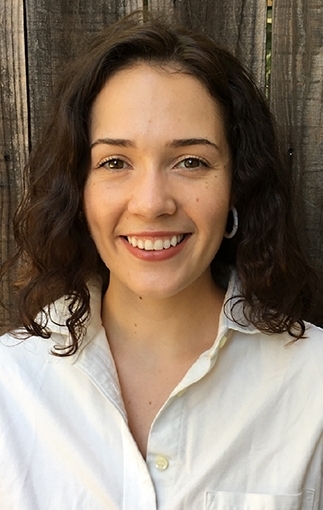
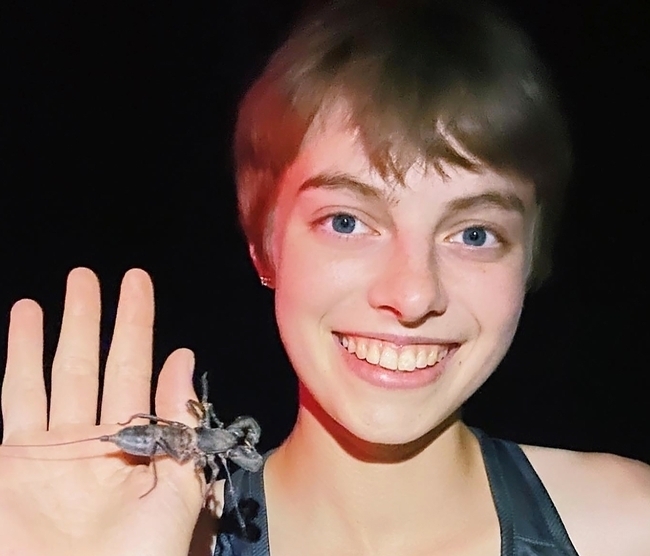
Entomology Games. The UC Davis Entomology Games team will be competing for regional honors and national representation. The team includes doctoral candidate Zachary Griebenow of the Phil Ward lab, captain; doctoral candidate Jill Oberski of the Ward lab; doctoral student Erin “Taylor” Kelly of the Geoffrey Attardo lab; and doctoral student Madison “Madi” Hendrick of the Ian Grettenberger.
The Entomology Games is a lively question-and-answer, college bowl-style competition on entomological facts played between university-sponsored student teams. It was formerly known as the Linnaean Games. The preliminary round is from 5 to 6 p.m., April 10. Plans are to hold three rounds with questions from each of the 10 categories: Biological Control, Behavior and Ecology, Economic and Applied Entomology, Medical-Urban-Veterinary Entomology, Morphology and Physiology, Biochemistry and Toxicology, Systematics and Evolution, Integrated Pest Management and Plant-Insect Interactions, History of Entomology, and Entomology in Popular Culture. (See UC Davis news story)
The final round is from 8 to 10 p.m., April 11. Both the championship team and the runner-up team will represent PBESA at the Entomological Society of America (ESA) meeting, Nov. 13-16 in Vancouver, British Columbia. Last year's national champion was the University of Hawaii, which edged Texas A&M University.
UC Davis has scored three national championships since 2015. In 2018, the University of California team won the national championship, defeating Texas A&M. The team included captain Ralph Washington Jr., then a UC Berkeley graduate student with a bachelor's degree in entomology from UC Davis; doctoral students Brendon Boudinot, Jill Oberski and Zachary Griebenow of the Phil Ward lab, and doctoral student Emily Bick of the Christian Nansen lab.
UC Davis won the national competition in both 2016 and 2015, defeating the University of Georgia in 2016, and the University of Florida in 2015.
A number of other UC Davis faculty and students will participate in the PBESA meeting. (See schedule.)
PBESA encompasses 11 Western states, parts of Canada and Mexico and several U.S. territories.
- In the United States: Alaska, Arizona, California, Hawai'i, Idaho, Montana, Nevada, Oregon, Utah, Washington, Wyoming
- U.S. Territories: American Samoa, the Federated States of Micronesia, Guam, Johnston Atoll, Commonwealth of the Northern Mariana Islands, Midway Islands, Wake Island
- In Canada: Alberta, British Columbia, Northwest Territories, Saskatchewan, Yukon
- In Mexico: Baja California, Baja California Sur, Sinaloa, Sonora
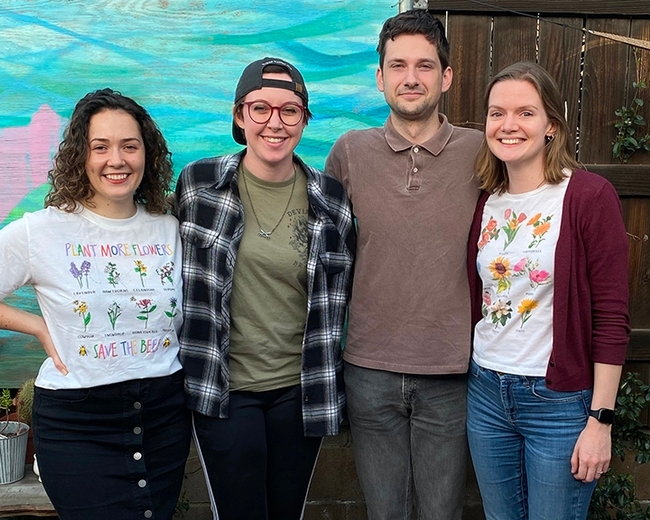
- Author: Kathy Keatley Garvey
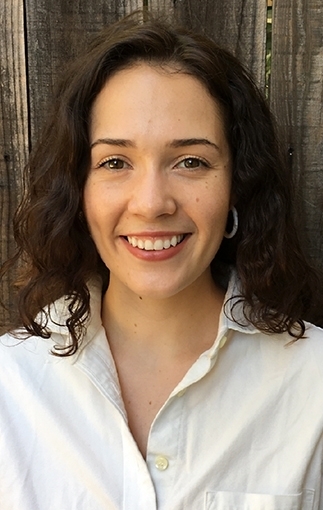
The award-winning trio:
- Medical entomologist-geneticist Geoffrey Attardo received the Medical, Urban, and Veterinary Entomology Award. (See news story)
- Doctoral student Erin Taylor Kelly of the Attardo lab won the Student Leadership Award (See news story)
- Undergraduate entomology student Gwen Erdosh of the Louie Yang lab and a member of the Research Scholars Program in Insect Biology, won the inaugural Dr. Stephen Garczynski Undergraduate Research Scholarship (See news story)
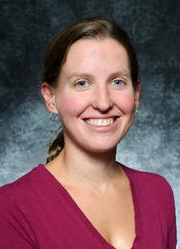
Rankin says her research "focuses on investigating species interactions and their effects on trophic dynamics and ecosystem services within the contexts of invasion biology, community ecology and evolutionary ecology." She received her bachelor's degree in biology in 2002 from Georgetown University, Washington, DC, and obtained her doctorate in biological sciences from UC San Diego in 2009. Then it was off to UC Davis for a year in the Yang lab before accepting a position as postdoctoral researcher with the University of Maryland's Department of Entomology. Rankin joined the UC Riverside faculty in 2013 as an assistant professor and advanced to associate professor in 2019.
In 2021 Rankin was named the recipient of two major awards: the Outstanding Faculty Mentor and the Academic Senate Distinguished Teaching Award. See her research and publications on her website.
Rankin's award was one of five awarded to UC Riverside entomologists:
- Mark Hoddle won the C. W. Woodworth Award
- Jessica Purcell, Distinction in Student Mentoring Award
- Dong-Hwan Choe, Distinguished Achievement in Extension Award
- Kerry Mauck, Plant-Insect Ecosystems Award
Results showed UC entomologists (from the two campuses) winning a total of eight awards, and USDA, four. (See the chart below) Congratulations, all!
Pacific Branch. The Pacific branch encompasses 11 Western states, parts of Canada and Mexico and several U.S. territories.
In the United States: Alaska, Arizona, California, Hawai, Idaho, Montana, Nevada, Oregon, Utah, Washington, Wyoming
U.S. Territories: American Samoa, the Federated States of Micronesia, Guam, Johnston Atoll, Commonwealth of the Northern Mariana Islands, Midway Islands, Wake Island
In Canada: Alberta, British Columbia, Northwest Territories, Saskatchewan, Yukon
In Mexico: Baja California, Baja California Sur, Sinaloa, Sonora
ESA, founded in 1889, is the world's largest organization serving the professional and scientific needs of entomologists and individuals in related disciplines. Its 7,000 members are affiliated with educational institutions, health agencies, private industry, and government. They are researchers, teachers, extension service personnel, administrators, marketing representatives, research technicians, consultants, students, pest management professionals, and hobbyists.
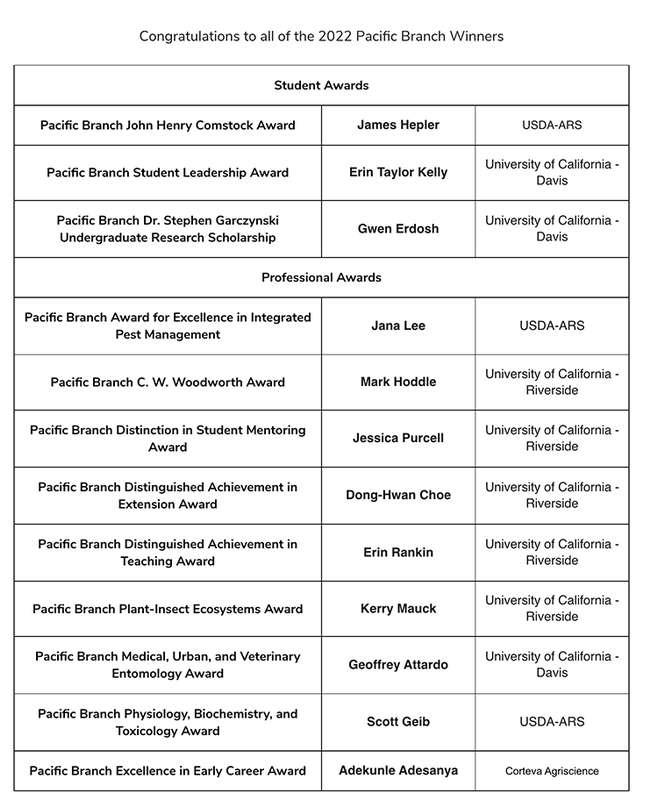
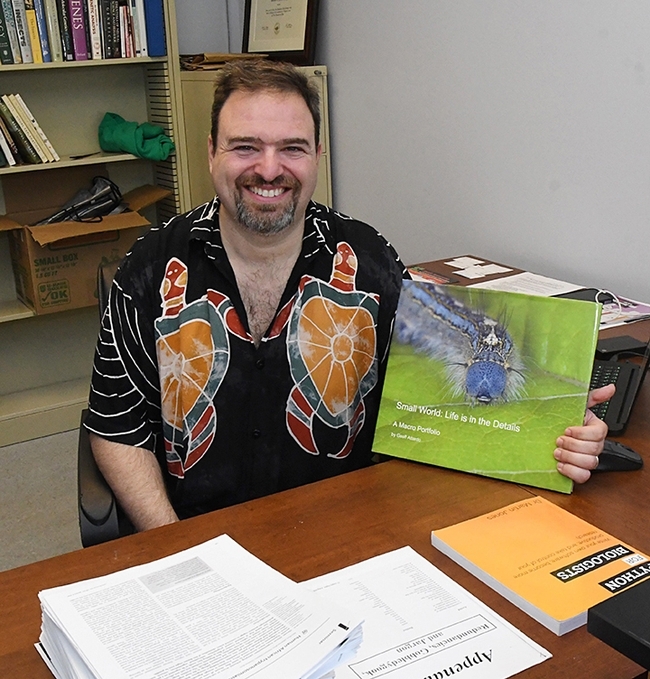
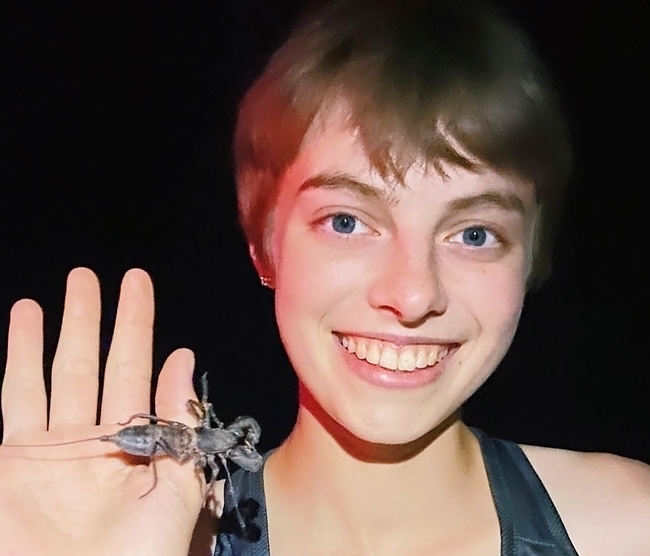
- Author: Kathy Keatley Garvey

By Geoff Attardo
Assistant Professor of Entomology and Nematology at UC Davis
California's changing climate is creating a myriad of public health concerns. Wildfires, intense heatwaves, and a drought are the most readily apparent. However, increasingly temperate winters are also facilitating the spread of invasive disease-spreading mosquitoes throughout the state. Just as our fire authorities need a robust set of tools to address wildfires, it is critical that mosquito control and public health professionals have a wide range of tools to protect Californians from mosquito-borne diseases.
The growing presence of Aedes aegypti mosquitoes, which can transmit the viruses that cause Zika, dengue, chikungunya, and yellow fever as well as the parasite that causes heartworm in pets, is a major public health threat. In 2013 this invasive species was detected in the Central Valley and has been found in California every year since. These mosquitoes cohabitate with humans and often hitchhike facilitating their spread.
Aedes aegypti lay eggs in flowerpots, water storage containers or anything capable of holding small amounts of water. Part of the problem, as highlighted in our research in Frontiers in Tropical Diseases, is that these mosquitoes have cryptic breeding sites in residential areas where mosquito control agencies can't easily inspect and treat.
In addition, their eggs can dry out and then hatch when rehydrated. In fact, when Aedes aegypti were detected in 2014 in the city of Exeter there was a large eradication effort. The effort appeared successful, as they were no longer detectable in 2015. Yet, the mosquitoes were detected in Exeter again in 2018. The unique biology of this invasive species has allowed it to expand its geographical range and today they are present in more than 300 cities in California.
Another key factor is their inherent resistance to a class of insecticides called pyrethroids, which have been a mainstay for adult mosquito control because they have low toxicity to humans and other animals. Work from our lab and the California Department of Public Health found increasing insecticide resistance in these mosquitoes (Parasites and Vectors) which limits the ability of mosquito control agencies to act against adult mosquitoes in a time of crisis.
In order to protect public health, mosquito control agencies need effective tools in their toolbox. One innovative approach takes advantage of the fact that male mosquitoes do not bite; only female mosquitoes bite and can spread viruses. This approach works by releasing sterile male Aedes aegypti mosquitoes. These male-only mosquitoes carry a self-limiting gene that prevents their female offspring from surviving. When they mate with females, this reduces the abundance of biting females in the next generation. One of the benefits of this species-specific approach is that it only targets the Aedes aegypti mosquito. This means that wildlife, such as butterflies and bees, are unharmed.
The public health threat of Aedes aegypti cannot be overstated. The World Health Organization (WHO) estimates that dengue fever causes approximately 40,000 deaths a year and Zika virus, of which there were over 5,100 symptomatic domestic cases in 2016, is known to cause serious birth defects and miscarriage as well as Guillain-Barré syndrome. The WHO also said “the potential public health benefit of practical and effective new tools to reduce or even eliminate diseases such as malaria and dengue is clear and widely recognized.”
A company called Oxitec is working with government agencies to bring its innovative mosquito control technology to the U.S. In August, they announced they are seeking regulatory approvals to expand their pilot program to bring their Friendly™ Aedes aegypti technology to California. I encourage regulators to allow the company to work with mosquito control agencies to determine the technology's effectiveness in California.
It's clear that we need efficient mosquito control tools, and we cannot wait until we have a public health emergency to act. As we have seen with the COVID pandemic it is critical to have an infrastructure in place, especially one that includes innovative – and proven – technologies, to help public health and mosquito controls stay ahead of the curve.
